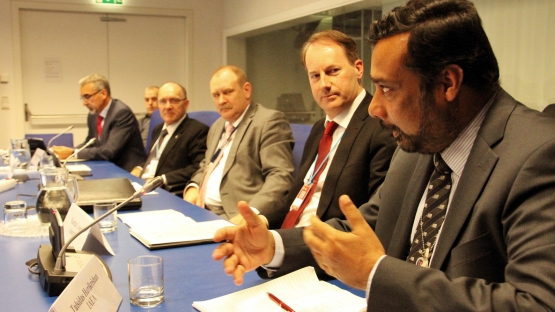Uranium is the main commercially available fuel source for nuclear power generation, which provided about 11 per cent of the world’s electricity in 2013. Safety, environmental and social requirements related to uranium mining are rigorous, as management and regulatory practices become more advanced and the search for constant improvement continues. These high standards must still be met even at times of restrained budgets.
This challenge was highlighted at a side event during the IAEA 58th General Conference. It also provided the participants with detailed information on the importance of maintaining "best practices" and avoiding complacency in the uranium mining industry, particularly during an economic downturn.
“Responsible uranium production has been of importance to the IAEA from its inception,” said Alexander Bychkov, IAEA Deputy Director General and Head of the Department of Nuclear Energy, speaking at the event on 24 September 2014. Despite the recent decrease in immediate uranium exploration and mining, following a sustained fall in the price of mined uranium, these activities are “still high by historical standards and many of our Member States have a longer term interest in its mining and exploration to secure future supplies,” he clarified.
The event also touched upon the newly emerged challenges for the industry, including expanding uranium production facilities in times of increased budgetary constraints or developing new facilities both in established markets as well as newcomer countries. Maintaining the momentum built up during more favourable economic times, including in regulatory, safety, health and environmental areas, remains a vital factor to ensure the sustainability of the uranium mining industry.
Challenges in maintaining security standards and regulations applicable to uranium production centres were also addressed at this meeting. The need for effective coordination of different agencies at various levels, including ground/site, national and international level was also reiterated to achieve and implement effective security governance of uranium production.
Martin Lyons, Assistant Director, Nuclear Safeguards at the Australian Safeguards and Non-Proliferation Office (ASNO), highlighted Australian examples of lessons learned, particularly on the security of uranium mining and milling sites, as well as transportation. He demonstrated how benchmarking practices against global good practices and international collaboration, especially peer reviews, greatly helped in continuous improvement. In addition, he highlighted that these efforts should also go hand-in-hand with community outreach programmes, based on a clear stakeholder mapping.
Findings From the Red Book
The side event, sponsored by Australia, also presented the key findings of the 2014 edition of the Red Book on uranium resources, production and demand, jointly published by the IAEA and the Nuclear Energy Agency (NEA) of the Organisation for Economic Cooperation and Development (OECD).
The Red Book shows that global uranium production has continued to increase between 2010 and 2012, albeit at a lower rate than in the previous two-year period. Uranium demand will continue to rise in the foreseeable future despite declining market prices since the 2011 Fukushima Daiichi Nuclear Power Plant accident, and lower electricity demand in some areas as a result of the global economic crisis . This authoritative world reference report on uranium also concludes that about seven per cent more uranium resources have been identified since the last report was published in 2012, adding almost 10 years to the existing resource base.
Publication of the Red Book is just one of the important activities intergovernmental organisations such as the IAEA undertake to help maintain standards in the uranium mining industry.
“The IAEA supports the development of a sustainable uranium production cycle in Member States,” added Harikrishnan Tulsidas, a uranium specialist at the IAEA. “Our activities are aimed at collecting and sharing knowledge of uranium resources among the Member States, to better develop and promote international standards.”


